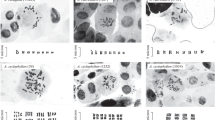Abstract
The karyomorphology of 18 Epimedium species were reported in this study. Among 18 species, the karyomorphology of eight taxa, namely E. ecalcaratum, E. pauciflorum, E. lishihchenii, E. dolichostemon, E. pudingense, E. baojingense, E. yingjiangense and E. shuichengense were reported for the first time. The chromosome numbers of all species studied are 2n = 2x = 12, except E. yingjiangense 2n = 4x = 24. Tetraploid was reported in genus Epimedium for the first time. All the Epimedium species, investigated in the present research, have a uniform karyotype with two types of chromosome, metacentric and submetacentric, except E. leptorrhizum and E. sagittatum, of which the sixth pair of chromosomes were subteleocentric. A secondary constriction was commonly found on the proximal side of the short arm of the chromosome pair 1 or 2. The karyotype symmetry of all investigated species was relatively primitive 1A, 2A or 3A. The speciation, infrageneric and intergeneric relationship of Epimedium in Berberidaceae were discussed.




Similar content being viewed by others
References
Franchet A (1886) Sur les especes du genre Epimedium. Bulletion de la Société Botanique de France 33(38–41):103–116
Guo BL, Xiao PG (1999) The flavonoids in Epimedium L. and their taxonomic significance. Acta Phytotax Sin 37:228–243
Guo BL, Pei LK, Xiao PG (2008) Further research on taxonomic significance of flavonoids in Epimedium (Berberidaceae). J Sys Evo 46:874–885
Hong DY (1990) Plant cytotaxonomy. Science Press, Beijing
Hoot SB, Magallón S, Crane PR (1999) Phylogeny of basal eudicots based on three molecular data sets: atpB, rbcL, and 18S nuclear ribosomal DNA sequences. Am J Bot 86:1–32
Kim YD, Jansen RK (1998) Chloroplast DNA restriction site variation and phylogeny of the Berberidaceae. Am J Bot 85:1766–1788
Kim YD, Kim SH, Kim CH, Jansen RK (2004) Phylogeny of Berberidaceae based on sequence of the chloroplast gene ndhF. Biochem Sys Eco 32:291–301
Koga S, Shoyama Y, Nishioka I (1991) Studies on Epimedium species: flavonol glycosides and isozymes. Biochem Sys Ecol 19:315–318
Komarov VL (1908) Revisio critica speciorum generis Epimedium L. Trudy Imperatorskago S. Petersburgskago Botanicheskago Sada 29:125–151
Krikorian AD, Connor SA, Fitter MS (1983) Chromosome number variation and karyotype stability in cultures and culture-derived plants. In: Ammirato PV, Yamada Y (eds) Handbook of plant cell culture. Macmillan Publishing Company, New York, pp 541–581
Levan A, Fredga K, Sandberg AA (1964) Nomenclacture for centromeric position on chromosomes. Hereditas 52:201–220
Liang HR, Yan WM (1991) Studies on the pollen morphology of Epimedium in China. Bull Bot Res 11:81–92
Linnaeus C (1753) Species Plantarum (1957 reprint). Ray Society, London
Ma SB, Hu ZH (1996) A karyotypic study on Podophylloideae (Berberidaceae). Acta Bot Yunnanica 18:325–330
Morren C, Decaisne J (1834) Obversation sur la flore du Japon suivies de la monographie du genre Epimedium. Annales des sciences 1 Naturelles 11. Botanique 2:347–361
Nakai R, Shoyama Y, Shirashi S (1996) Genetic characterization of Epimedium species using random amplified polymorphic DNA (RAPD) and PCR-restriction fragment length polymorphism (RFLP) diagnosis. Biol Pharm Bull 19:67–70
Raven PH (1975) The bases of angiosperm phylogeny: cytology. Ann Mo Bot Gard 62:724–764
Romero Zarco Z (1986) A new method for estimating karyo-type asymmetry. Taxon 35:526–530
Sheng MY, Chen QF (2007) Karyotype analysis of six Epimedium species native to Guizhou, China. Guihaia 27:440–443
Sheng MY, Chen QF (2008) Giemsa C-banding analysis in eight species of genus Epimedium (Berberidaceae). J Wuhan Bot Res 26:433–436
Sheng MY, Chen QF, Yang QX (2008) Variation in icariin and flavonoid contents of barrenwort accessions native to Guizhou, China. Biochem Sys Ecol 36:719–723
Stace CA (2000) Cytology and cytogenetics as a fundamental taxonomic resource for the 20th and 21th centuries. Taxon 49:451–477
Stearn WT (1938) Epimedium and Vancouveria (Berberidaceae), a monograph. Bot J Linn Soc 51:409–535
Stearn WT (2002) The Genus Epimedium and other herbaceous Berberidaceae. Timber Press, Portland
Stebbins GL (1950) Variation and evolution in plants. Columbia University Press, New York
Stebbins GL (1971) Chromosomal evolution in higher plants. Edward Arnold Ltd, London
Sun Y (2004) Characterization of medicinal Epimedium species by 5S rRNA gene spacer sequencing. Planta Med 70:287–288
Sun Y, Fung KP, Leung PC, Shaw PC (2005) A phylogenetic analysis of Epimedium (Berberidaceae) based on nuclear ribosomal DNA sequences. Mol Phylogenet Evol 35:287–291
Takahashi C (1989) Karyomorphological studies on speciation of Epmedium and its allied Vancouveria with special reference to C-bands. Sci Hiroshima Uni 2:159–269
Tanaka R, Takahashi C (1981) Comparative karyotype analysis in Epimedium species by C-banding (1) E. sempervirens var. hypoglaucum and E. perralderianum. J Jpn Bot 56:17–24
Wang T, Su YJ, Zhu JM, Fan GK, Chen J (2001) RAPD analysis on some species of Berberidaceae. Bull Bot Res 21:428–431
Wu ZY, Lu AM, Tang CY (2003) The families and genera of angiosperms in China. Science Press, Beijing
Xie JP, Sun WJ (2006) Progress of chemical materials and pharmacy of genus Epimedium plants. Strait Pharm J 18:17–20
Ying TS (2002) Petal evolution and distribution patterns of Epimedium L. (Berberidaceae). Acta Phytotax Sin 40:481–489
Zhang KT, Wang PL (1983) Study on the pollen morphology of the family Berberidaceae. Acta Phytotax Sin 21:130–141
Zhang Y, Xiao CH, Meng XL (1995) Flavonoids contents determined and resources utilized of 8 species for sale native to Sichuan. Chin J Chin Materia Medica 20:201–202
Zhang L, Wang Y, Mao HT, Wen PE, Cui SL, Li XB (2002) Study on the inhibition of telomerase activity and regulated mechanism in human cancer cell by icarrin. Chin J Immunol 18:191–196
Zhang ML, Christian HU, Joachim WK (2007) Phylogeny and biogeography of Epimedium/Vancouveria (Berberidaceae): Western North American–East Asian disjunctions, the origin of European mountain plant taxa, and East Asian species diversity. Sys Bot 32:81–92
Author information
Authors and Affiliations
Corresponding author
Rights and permissions
About this article
Cite this article
Sheng, MY., Wang, LJ. & Tian, XJ. Karyomorphology of eighteen species of genus Epimedium (Berberidaceae) and its phylogenetic implications. Genet Resour Crop Evol 57, 1165–1176 (2010). https://doi.org/10.1007/s10722-010-9556-6
Received:
Accepted:
Published:
Issue Date:
DOI: https://doi.org/10.1007/s10722-010-9556-6




